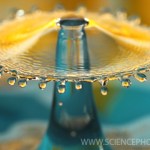Motion
Grades are in. So, let me just say a couple of trends that I saw on the physical science final exam.
Gravity on the moon
I asked the question: "why is the gravitational force on an astronaut less on the moon than on Earth?"
The simplest answer is that the gravitational field on the moon is smaller than on Earth (I would accept that answer). Why is this? It is because the moon as a much smaller mass even though it also has a smaller radius (that idea is rather complicated for this class - that gravitational force depends on both mass and radius). I would also take "the mass is smaller" as…
Fluids are a constant source of inspiration for high speed photography. Water and milk are two of the common liquids around us every day, but still their complex behavior is a source of wonder. Fluid scientists are still pioneering some of the basic equations that are responsible for the complex motion of fluids. In these pictures a drop of liquid is falling into a container of liquid. The first falling drop creates a recoil splash that shoots up out of the container. Just when the recoil droplet gets to the top of its motion a second falling droplet collides. The timing often happens…
This is how.
-----------
This image was provided by Ted Kinsman for Photo Synthesis.
With high speed photography, I can use a high voltage spark to create a flash of only 1/1,000,000th of a second in duration. The problem is that there are not a lot of things that move this fast that such a flash is required to stop the motion. Bullets are such a subject requiring a very high speed flash system. Around the lab we jokingly call this "ludicrous speed". After photographing bullets hit just about every conceivable object it is time to move on to other subjects. In this case a paint ball is sent into the edge of a straight razor blade. The paint ball crosses two optical…
I have photographed jugglers several times in the past for physics text books. I have been impressed with the level of skill some jugglers can obtain. It is difficult enough to juggle three balls, four is more difficult, and fire is a another story. When objects move in a circle they can undergo some fairly complicated motions. What would be the best way to show this motion in a still image?
In this case the camera is panned by the juggler at a constant rate on a computer controlled pan head. When the juggler is about the center of the…
I actually have some important things to do. However, I thought I would make another scratch program. Yes, this will all lead to something useful (that is what I told my wife). Anyway, in this program, I made a spaceship with 4 thrusters. The great thing about this is it show what forces do to the motion of an object. I already had a suggestion to make it into a game with a score.
Learn more about this project
Use the arrow keys to turn on the 4 thrusters.
I can't remember how I found this, but [Scratch](http://scratch.mit.edu) is a graphical programming language developed at MIT. My kids love this. In order to make sure they don't know more than I do, I created my own scratch program. I am sure someone from the scratch community will attack it for some reason, but I am ok with that.
The program shows a numerical calculation of the motion of a box with a constant force on it. You change the mass and the force. It "sort of" plots the position as a function of time. Don't worry python, I still think you are the best.
Learn more about…
Sometimes, gravity and motion has the power to mesmerize me. I found this online game called "compulse" which was so much fun, that I spent about 90 minutes this week just playing this game until I had beaten every level on the "pro" setting. Yikes. (My score is 104 under par, 8 under pro.)
And so, in the interest of bringing it to you, I've tried to embed it into my website. Have fun playing if it works in your browser (I told you to use firefox or safari), and if you enjoy playing with the mechanics of motion as much as I do, maybe you, too, have the interest it takes to be a physicist!…
